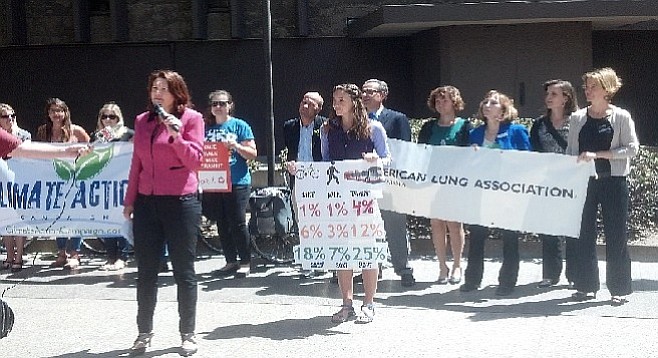 Facebook
Facebook
 X
X
 Instagram
Instagram
 TikTok
TikTok
 Youtube
Youtube

A host of green-minded organizations gathered in front of city hall on Monday afternoon (April 6) to ask mayor Kevin Faulconer to devote additional funding to begin implementing some of the measures in his draft Climate Action Plan, which calls for halving the city's carbon footprint by 2035.
"To do that, the city needs to reduce the number of people driving to work and increase the number walking, biking, or taking transit," said Nicole Capretz, director of the newly formed environmental watchdog group Climate Action Campaign.
Specifically, the plan calls for increasing the share of cyclist and pedestrian commuters, both estimated at 1 percent of the population currently, to 18 and 7 percent, respectively. Transit use, in order to meet the plan's targets, will need to rise from a 4 percent share of daily commuters to 25 percent by 2035.
"These are ambitious goals that will only happen if they're prioritized by our mayor," Capretz continued. "What are the mayor's plans for reaching these goals? We don't know — that's why we're here today asking the mayor to outline his road map."
Andy Hanshaw of the San Diego County Bicycle Coalition said the city has work to do in improving safety for cyclists, noting that where improvements have been made, ridership is up.
"We need to do more than resurface our streets — we need to repurpose them at the same time," said Hanshaw, referring to a plan by Faulconer to pave 1000 miles of city roads in the next five years. "The city's recent placement of wider, safer bike lanes on Fourth and Fifth Avenues are a good example of this, and new ridership numbers along these corridors are showing a dramatic increase."
The city's climate plan is currently in an environmental review phase, though activists have argued that this shouldn't necessarily delay beginning work.
No specific funding requests were made aside from a broad plea for spending "sufficient to meet the plan's goals." Faulconer's office is expected to release a budget proposal early next week.


A host of green-minded organizations gathered in front of city hall on Monday afternoon (April 6) to ask mayor Kevin Faulconer to devote additional funding to begin implementing some of the measures in his draft Climate Action Plan, which calls for halving the city's carbon footprint by 2035.
"To do that, the city needs to reduce the number of people driving to work and increase the number walking, biking, or taking transit," said Nicole Capretz, director of the newly formed environmental watchdog group Climate Action Campaign.
Specifically, the plan calls for increasing the share of cyclist and pedestrian commuters, both estimated at 1 percent of the population currently, to 18 and 7 percent, respectively. Transit use, in order to meet the plan's targets, will need to rise from a 4 percent share of daily commuters to 25 percent by 2035.
"These are ambitious goals that will only happen if they're prioritized by our mayor," Capretz continued. "What are the mayor's plans for reaching these goals? We don't know — that's why we're here today asking the mayor to outline his road map."
Andy Hanshaw of the San Diego County Bicycle Coalition said the city has work to do in improving safety for cyclists, noting that where improvements have been made, ridership is up.
"We need to do more than resurface our streets — we need to repurpose them at the same time," said Hanshaw, referring to a plan by Faulconer to pave 1000 miles of city roads in the next five years. "The city's recent placement of wider, safer bike lanes on Fourth and Fifth Avenues are a good example of this, and new ridership numbers along these corridors are showing a dramatic increase."
The city's climate plan is currently in an environmental review phase, though activists have argued that this shouldn't necessarily delay beginning work.
No specific funding requests were made aside from a broad plea for spending "sufficient to meet the plan's goals." Faulconer's office is expected to release a budget proposal early next week.
Comments